Sponsored content by Azbil
In recent years, there has been increasing awareness of the importance of health and hygiene in workplace settings. The COVID-19 pandemic has amplified this further. In this new era of safe distancing and mask wearing, how can building owners or facility managers create a safe and healthy environment that can minimise the risk of infection transmission for workers?
Respiratory diseases can spread through respiratory droplets and airborne or contact transmission. COVID-19 is primarily transmitted through exposure to individuals who expel respiratory droplets containing the virus.
However, airborne transmission cannot be ruled out completely, according to the World Health Organisation. Airborne transmission occurs when individuals inhale respiratory droplet nuclei that remain infectious while suspended in the air.
Building owners and facility managers can play their part in infection prevention and control by improving indoor ventilation to prevent airborne transmission.
The ventilation process involves introducing outdoor fresh air into indoor spaces while discharging the same volume of indoor air outside. Increased ventilation can dilute the concentration of viruses in the air or remove the air containing the respiratory droplet nuclei. This enhances indoor air quality, creating a healthier environment for office workers.

THE CENTRAL AIR-CONDITIONING SYSTEM AS A PRACTICAL SOLUTION FOR CONTROLLING INFECTIONS
Building owners and facility managers can utilise the air-conditioning system to improve indoor ventilation and reduce the risks of infection. But it is critical for them to select the right type of air-conditioning system and make adjustments to its design to optimise its performance.
Here, the central air-conditioning system offers a practical solution as it is able to constantly introduce fresh air indoors. Using shared air conditioners, the system draws in outdoor air and delivers cool (or warm) air within the building, enabling it to ventilate multiple areas.
The central air-conditioning system is designed to allow the mixture of return indoor air and fresh air from outside to pass through installed filters. This process plays an important role in increasing the level of air cleanliness when the air is recirculated. It allows the central air-conditioning system to effectively dilute small respiratory droplets and respiratory droplet nuclei in a room.
 In tackling the spread of airborne respiratory diseases, the central air-conditioning system is also a better solution compared to another alternative, namely the variable refrigerant flow (VRF) system. Unlike the VRF system, central air-conditioning systems have the flexibility to adjust the amount of fresh air introduced indoors. Depending on indoor air quality conditions, it can increase or decrease the amount of fresh air for ventilation purposes.
In tackling the spread of airborne respiratory diseases, the central air-conditioning system is also a better solution compared to another alternative, namely the variable refrigerant flow (VRF) system. Unlike the VRF system, central air-conditioning systems have the flexibility to adjust the amount of fresh air introduced indoors. Depending on indoor air quality conditions, it can increase or decrease the amount of fresh air for ventilation purposes.
 The central air-conditioning system also has better-performing filters, which are able to trap respiratory droplets and fine particles more effectively. On the other hand, the VRF system is usually fitted with lower-efficiency filters which also require regular replacement and cleaning. From a cost perspective, this is not very ideal.
The central air-conditioning system also has better-performing filters, which are able to trap respiratory droplets and fine particles more effectively. On the other hand, the VRF system is usually fitted with lower-efficiency filters which also require regular replacement and cleaning. From a cost perspective, this is not very ideal.
HOW THE CENTRAL AIR-CONDITIONING SYSTEM HELPS TO CONTROL INFECTIONS
The central air-conditioning system aids in preventing the spread of airborne respiratory diseases by improving ventilation, enhancing the indoor environment quality and controlling humidity.
Improving ventilation and the flow of fresh air
Through the all-fresh-air operation, only fresh air is delivered for air conditioning. Using dampers as a mechanism to control airflow and regulate ventilation, the system prevents returned air from being recirculated back into the room.
 In addition, the fresh air-cooling control function is able to actively draw in lower-temperature fresh air for air-conditioning purposes, when an outdoor air temperature is lower than the indoor temperature.
In addition, the fresh air-cooling control function is able to actively draw in lower-temperature fresh air for air-conditioning purposes, when an outdoor air temperature is lower than the indoor temperature.
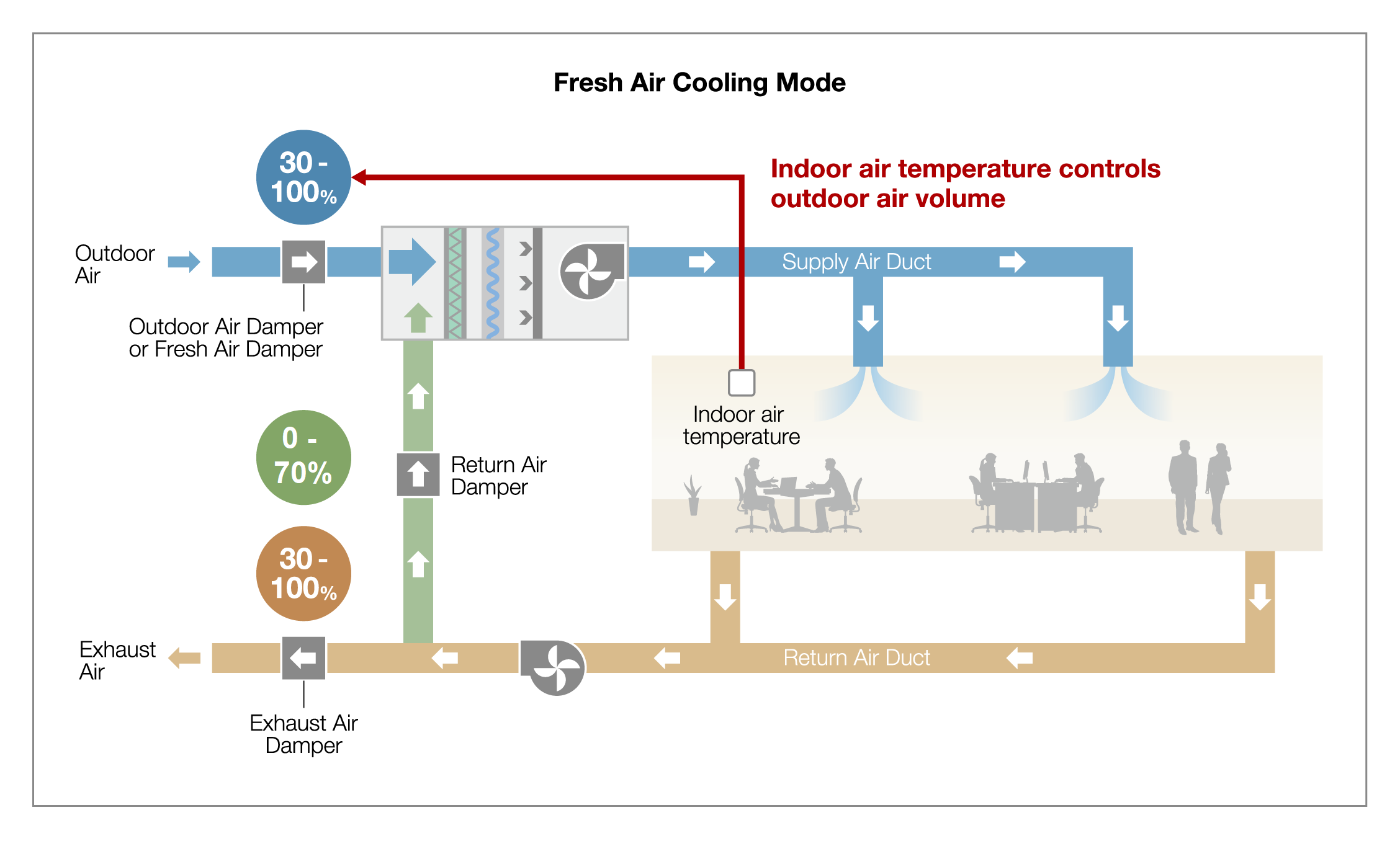
The central air-conditioning system is also able to maintain carbon dioxide (CO2) within a healthy range, allowing the preservation of indoor air quality. Through the CO2 concentration control function, CO2 can be constantly measured and adjustments can be made to the flow of fresh air to correspond with the density of the crowd in the room.
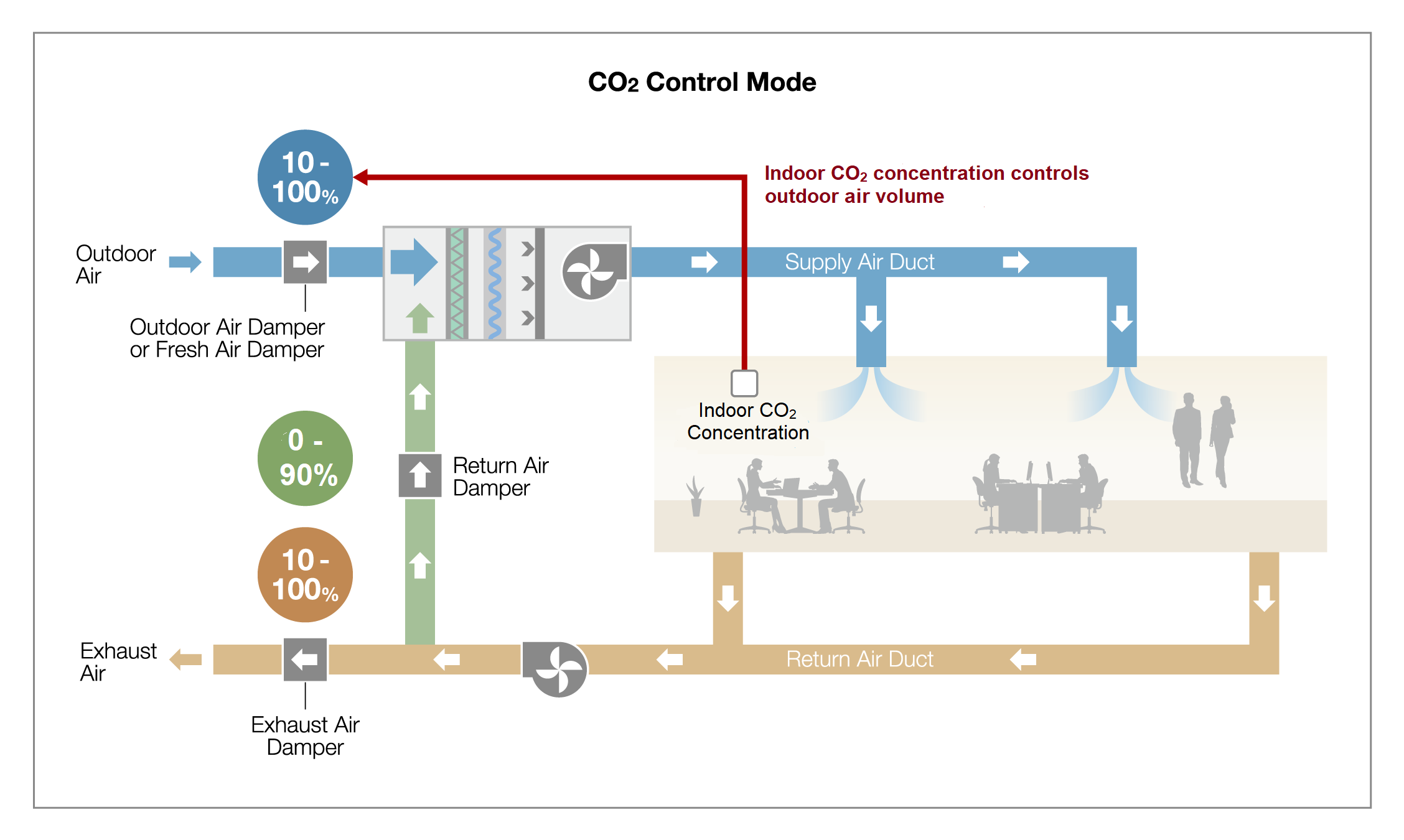
Improving indoor environment quality through the use of filters
Apart from increasing ventilation, central air-conditioning systems can help to prevent the airborne transmission of COVID-19 through the filtering process. While the installed filter in the air conditioner collects and removes dust when air passes through, the filter can also remove small respiratory droplets and respiratory droplet nuclei. The removal of airborne pollutants and viruses enhances the indoor environment quality which helps to protect the health of workers.

Controlling humidity through humidifiers
Research* suggests that controlling temperature and humidity in indoor spaces can assist in inactivating viruses or reducing the transmission of infectious airborne microorganisms.
Central air-conditioning systems are equipped with humidifiers that are able to control the amount of humidity in a room. These include vaporising, steam or pan type humidifiers.
Design of the central air-conditioning system is critical
While the features of a central air-conditioning system make it an ideal solution to manage the spread of infections, the design of the system is just as important to optimise its function as an infection countermeasure.
The demand control ventilation (DCV) function is an important element of the central air-conditioning system. This allows the system to automatically adjust the ventilation level to maximise indoor environment quality by taking into account various factors such as the occupancy level.
 However, to optimise the performance of the DCV, engineers need to consider several factors in the design and structure of the system. For example, they may need to install a large-enough outdoor air and exhaust duct that can allow the all-fresh-air operation or install a damper to regulate airflow. It may also be necessary to fit an airflow control device that can accurately measure the fresh air volume. Engineers can also install a sensor that can measure the leading indicator of air quality so that ventilation volume can be controlled according to the occupancy level.
However, to optimise the performance of the DCV, engineers need to consider several factors in the design and structure of the system. For example, they may need to install a large-enough outdoor air and exhaust duct that can allow the all-fresh-air operation or install a damper to regulate airflow. It may also be necessary to fit an airflow control device that can accurately measure the fresh air volume. Engineers can also install a sensor that can measure the leading indicator of air quality so that ventilation volume can be controlled according to the occupancy level.
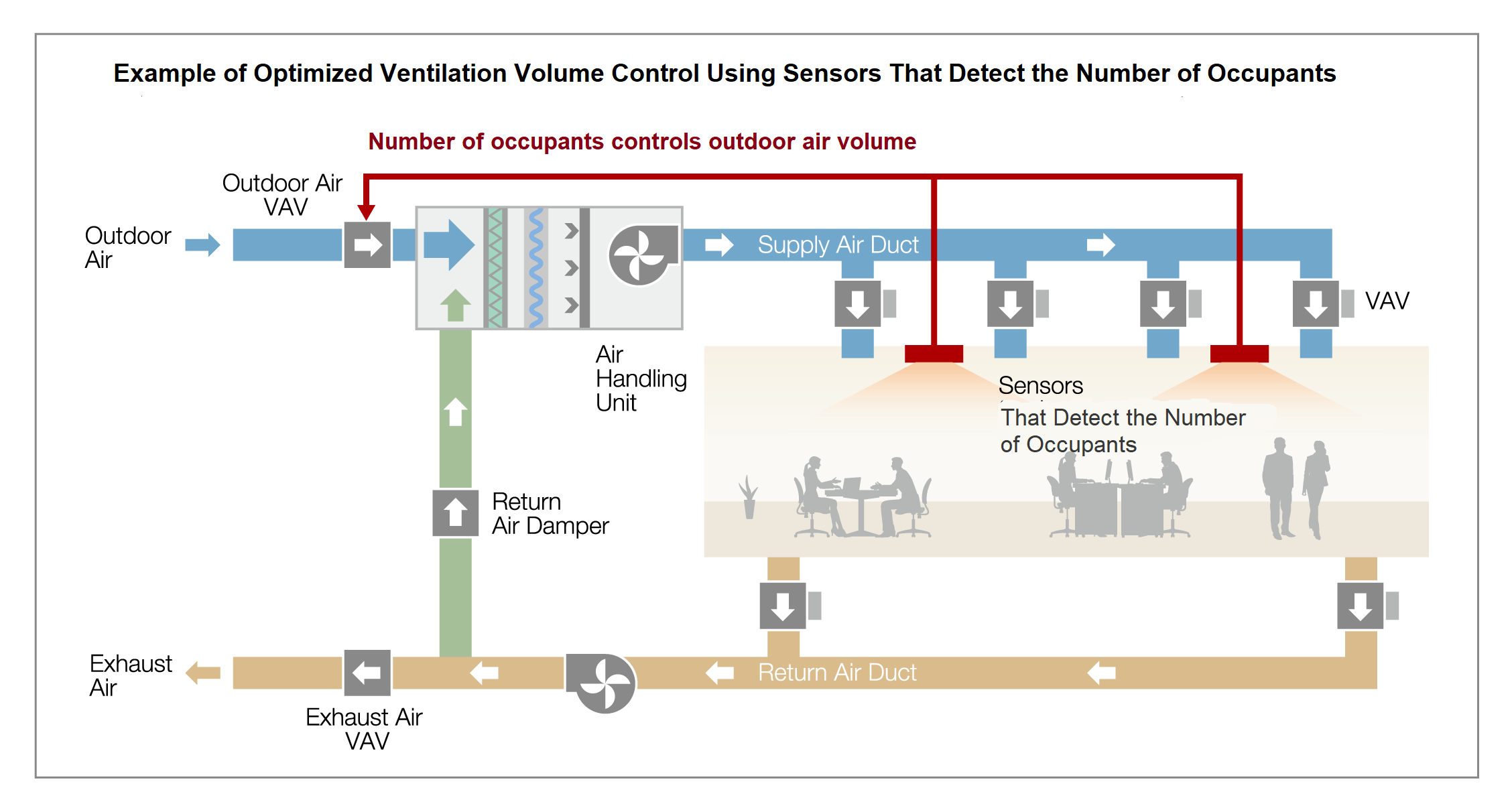
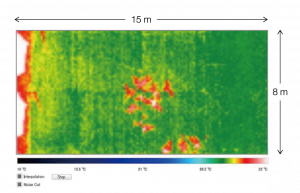
As part of pandemic readiness planning, it is recommended to have isolated spaces in the building where infected persons can be temporarily isolated. To control the spread of infection, it is necessary to maintain constant negative pressure to prevent leakage or air from this room to external areas. A variable air volume system can be installed in the outdoor air duct and the exhaust duct of the central air-conditioning system to help maintain this negative air pressure with adjacent spaces. In this room, the forced ventilation function needs to be activated after use.
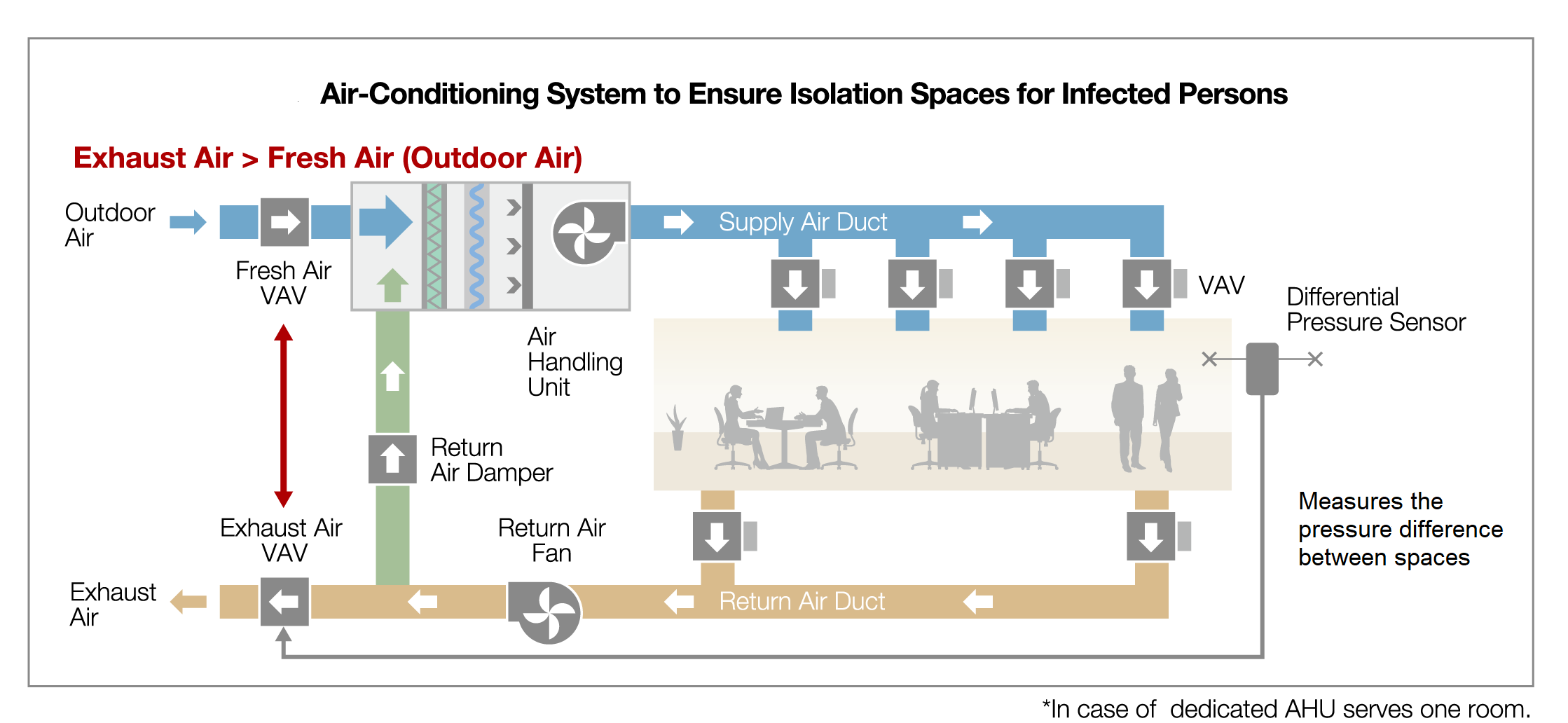
Ventilation-related intervention through the central air-conditioning system: proactiveness is key
The COVID-19 pandemic has elevated the need to make workplaces safe for occupancy. Building owners, facility managers, and design engineers can take the lead by introducing airflow- and ventilation-related interventions to manage the transmission of current and future airborne infectious diseases.
Proactively implementing infection countermeasure functions into the design of central air-conditioning systems can help to optimise airflow, purify the air and lower the overall concentration of airborne viruses. This can play a role in helping to reduce the spread of airborne infectious diseases.
• For more information, download the white paper titled “Countermeasures for preventing airborne disease transmission indoors” by Azbil Corporation.
*American Society of Heating, Refrigerating and Air-Conditioning Engineers, ASHRAE Position Document on Infectious Aerosols (2020)
International WELL Building Institute, Strategies from the WELL Building Standard to support in the fight against COVID-19 (2020)

 Malaysia
Malaysia Hong Kong
Hong Kong Indonesia
Indonesia Tiếng Việt
Tiếng Việt ประเทศไทย
ประเทศไทย










